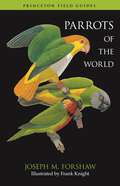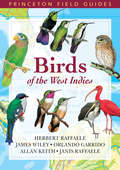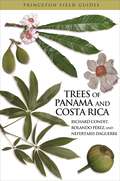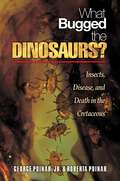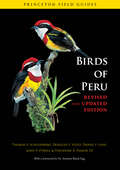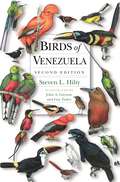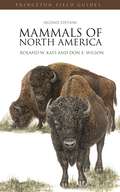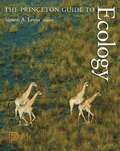- Table View
- List View
Why Size Matters: From Bacteria to Blue Whales
by John Tyler BonnerJohn Tyler Bonner, one of our most distinguished and creative biologists, here offers a completely new perspective on the role of size in biology. In his hallmark friendly style, he explores the universal impact of being the right size. By examining stories ranging from Alice in Wonderland to Gulliver's Travels, he shows that humans have always been fascinated by things big and small. Why then does size always reside on the fringes of science and never on the center stage? Why do biologists and others ponder size only when studying something else--running speed, life span, or metabolism? Why Size Matters, a pioneering book of big ideas in a compact size, gives size its due by presenting a profound yet lucid overview of what we know about its role in the living world. Bonner argues that size really does matter--that it is the supreme and universal determinant of what any organism can be and do. For example, because tiny creatures are subject primarily to forces of cohesion and larger beasts to gravity, a fly can easily walk up a wall, something we humans cannot even begin to imagine doing. Bonner introduces us to size through the giants and dwarfs of human, animal, and plant history and then explores questions including the physics of size as it affects biology, the evolution of size over geological time, and the role of size in the function and longevity of living things. As this elegantly written book shows, size affects life in its every aspect. It is a universal frame from which nothing escapes.
Why Size Matters: From Bacteria to Blue Whales
by John Tyler BonnerJohn Tyler Bonner, one of our most distinguished and creative biologists, here offers a completely new perspective on the role of size in biology. In his hallmark friendly style, he explores the universal impact of being the right size. By examining stories ranging from Alice in Wonderland to Gulliver's Travels, he shows that humans have always been fascinated by things big and small. Why then does size always reside on the fringes of science and never on the center stage? Why do biologists and others ponder size only when studying something else--running speed, life span, or metabolism? Why Size Matters, a pioneering book of big ideas in a compact size, gives size its due by presenting a profound yet lucid overview of what we know about its role in the living world. Bonner argues that size really does matter--that it is the supreme and universal determinant of what any organism can be and do. For example, because tiny creatures are subject primarily to forces of cohesion and larger beasts to gravity, a fly can easily walk up a wall, something we humans cannot even begin to imagine doing. Bonner introduces us to size through the giants and dwarfs of human, animal, and plant history and then explores questions including the physics of size as it affects biology, the evolution of size over geological time, and the role of size in the function and longevity of living things. As this elegantly written book shows, size affects life in its every aspect. It is a universal frame from which nothing escapes.
Parrots of the World
by Joseph M. Forshaw Frank KnightFrom the macaws of South America to the cockatoos of Australia, parrots are among the most beautiful and exotic birds in the world--and also among the most endangered. This stunningly illustrated, easy-to-use field guide covers all 356 species and well-differentiated subspecies of parrots, and is the only guide organized by geographical distribution--Australasian, Afro-Asian, and neotropical. It features 146 superb color plates depicting every kind of parrot, as well as detailed, facing-page species accounts that describe key identification features, distribution, subspeciation, habitat, and status. Color distribution maps show ranges of all subspecies, and field identification is further aided by relevant upperside and underside flight images. This premier field guide also shows where to observe each species in the wild, helping make this the most comprehensive and user-friendly guide to the parrots of the world. The only parrot guide to focus on geographical distribution Covers all 356 species Features 146 color plates depicting all species and well-differentiated subspecies Provides detailed facing-page species accounts that describe key identification features, distribution, subspeciation, habitat, and status Includes color distribution maps Shows where to observe each species in the wild
Parrots of the World
by Joseph M. Forshaw Frank KnightFrom the macaws of South America to the cockatoos of Australia, parrots are among the most beautiful and exotic birds in the world--and also among the most endangered. This stunningly illustrated, easy-to-use field guide covers all 356 species and well-differentiated subspecies of parrots, and is the only guide organized by geographical distribution--Australasian, Afro-Asian, and neotropical. It features 146 superb color plates depicting every kind of parrot, as well as detailed, facing-page species accounts that describe key identification features, distribution, subspeciation, habitat, and status. Color distribution maps show ranges of all subspecies, and field identification is further aided by relevant upperside and underside flight images. This premier field guide also shows where to observe each species in the wild, helping make this the most comprehensive and user-friendly guide to the parrots of the world. The only parrot guide to focus on geographical distribution Covers all 356 species Features 146 color plates depicting all species and well-differentiated subspecies Provides detailed facing-page species accounts that describe key identification features, distribution, subspeciation, habitat, and status Includes color distribution maps Shows where to observe each species in the wild
Birds of the West Indies (PDF)
by Herbert A. Raffaele James Wiley Orlando H. Garrido Allan Keith Janis I. Raffaele Tracy Pedersen Kristin WilliamsFully illustrated, easy to use, and completely up-to-date, Birds of the West Indies is the only field guide that covers all of the bird species known to occur in the region--including migrants and infrequently occurring forms. Each species is represented by a full description that includes identification field marks, status and range, habitat, and voice. A map showing the bird's distribution accompanies many species accounts, and plumages of all species are depicted in ninety-three beautifully rendered color plates. Bird lovers, vacationing tourists, local residents, and "armchair travelers" will all want to own this definitive field guide to the birds of the West Indies. Includes all species recorded in the region Features ninety-three color plates with concise text on facing pages for quick reference and easy identification Species accounts cover identification, voice, status and habitat, and range Color distribution maps
Birds of the West Indies
by Herbert A. Raffaele James Wiley Orlando H. Garrido Allan Keith Janis I. Raffaele Tracy Pedersen Kristin WilliamsFully illustrated, easy to use, and completely up-to-date, Birds of the West Indies is the only field guide that covers all of the bird species known to occur in the region--including migrants and infrequently occurring forms. Each species is represented by a full description that includes identification field marks, status and range, habitat, and voice. A map showing the bird's distribution accompanies many species accounts, and plumages of all species are depicted in ninety-three beautifully rendered color plates. Bird lovers, vacationing tourists, local residents, and "armchair travelers" will all want to own this definitive field guide to the birds of the West Indies. Includes all species recorded in the region Features ninety-three color plates with concise text on facing pages for quick reference and easy identification Species accounts cover identification, voice, status and habitat, and range Color distribution maps
Trees of Panama and Costa Rica
by Richard Condit Rolando Pérez Nefertaris DaguerreThis is the first field guide dedicated to the diverse tree species of Panama and Costa Rica. Featuring close to 500 tropical tree species, Trees of Panama and Costa Rica includes superb color photos, abundant color distribution maps, and concise descriptions of key characteristics, making this guide readily accessible to botanists, biologists, and casual nature lovers alike. The invaluable introductory chapters discuss tree diversity in Central America and the basics of tree identification. Family and species accounts are treated alphabetically and describe family size, number of genera and species, floral characteristics, and relative abundance. Color distribution maps supplement the useful species descriptions, and facing-page photographic plates detail bark, leaf, flower, or fruit of the species featured. Helpful appendices contain a full glossary, a comprehensive guide to leaf forms, and a list of families not covered. The only tree guide to cover both Panama and Costa Rica together Covers almost 500 species 438 high-resolution color photos 480 color distribution maps and two general maps Concise and jargon-free descriptions of key characteristics for every species Full glossary and guide to leaf forms included
Trees of Panama and Costa Rica
by Richard Condit Rolando Pérez Nefertaris DaguerreThis is the first field guide dedicated to the diverse tree species of Panama and Costa Rica. Featuring close to 500 tropical tree species, Trees of Panama and Costa Rica includes superb color photos, abundant color distribution maps, and concise descriptions of key characteristics, making this guide readily accessible to botanists, biologists, and casual nature lovers alike. The invaluable introductory chapters discuss tree diversity in Central America and the basics of tree identification. Family and species accounts are treated alphabetically and describe family size, number of genera and species, floral characteristics, and relative abundance. Color distribution maps supplement the useful species descriptions, and facing-page photographic plates detail bark, leaf, flower, or fruit of the species featured. Helpful appendices contain a full glossary, a comprehensive guide to leaf forms, and a list of families not covered. The only tree guide to cover both Panama and Costa Rica together Covers almost 500 species 438 high-resolution color photos 480 color distribution maps and two general maps Concise and jargon-free descriptions of key characteristics for every species Full glossary and guide to leaf forms included
What Bugged the Dinosaurs?: Insects, Disease, and Death in the Cretaceous
by George Poinar Jr. Roberta PoinarMillions of years ago in the Cretaceous period, the mighty Tyrannosaurus rex--with its dagger-like teeth for tearing its prey to ribbons--was undoubtedly the fiercest carnivore to roam the Earth. Yet as What Bugged the Dinosaurs? reveals, T. rex was not the only killer. George and Roberta Poinar show how insects--from biting sand flies to disease-causing parasites--dominated life on the planet and played a significant role in the life and death of the dinosaurs. The Poinars bring the age of the dinosaurs marvelously to life. Analyzing exotic insects fossilized in Cretaceous amber at three major deposits in Lebanon, Burma, and Canada, they reconstruct the complex ecology of a hostile prehistoric world inhabited by voracious swarms of insects. The Poinars draw upon tantalizing new evidence from their amazing discoveries of disease-producing vertebrate pathogens in Cretaceous blood-sucking flies, as well as intestinal worms and protozoa found in fossilized dinosaur excrement, to provide a unique view of how insects infected with malaria, leishmania, and other pathogens, together with intestinal parasites, could have devastated dinosaur populations. A scientific adventure story from the authors whose research inspired Jurassic Park, What Bugged the Dinosaurs?? offers compelling evidence of how insects directly and indirectly contributed to the dinosaurs' demise.
Plows, Plagues, and Petroleum: How Humans Took Control of Climate
by William F. RuddimanThe impact on climate from 200 years of industrial development is an everyday fact of life, but did humankind's active involvement in climate change really begin with the industrial revolution, as commonly believed? Plows, Plagues, and Petroleum has sparked lively scientific debate since it was first published--arguing that humans have actually been changing the climate for some 8,000 years--as a result of the earlier discovery of agriculture.The "Ruddiman Hypothesis" will spark intense debate. We learn that the impact of farming on greenhouse-gas levels, thousands of years before the industrial revolution, kept our planet notably warmer than if natural climate cycles had prevailed--quite possibly forestalling a new ice age.Plows, Plagues, and Petroleum is the first book to trace the full historical sweep of human interaction with Earth's climate. Ruddiman takes us through three broad stages of human history: when nature was in control; when humans began to take control, discovering agriculture and affecting climate through carbon dioxide and methane emissions; and, finally, the more recent human impact on climate change. Along the way he raises the fascinating possibility that plagues, by depleting human populations, also affected reforestation and thus climate--as suggested by dips in greenhouse gases when major pandemics have occurred. While our massive usage of fossil fuels has certainly contributed to modern climate change, Ruddiman shows that industrial growth is only part of the picture. The book concludes by looking to the future and critiquing the impact of special interest money on the global warming debate. In the afterword, Ruddiman explores the main challenges posed to his hypothesis, and shows how recent investigations and findings ultimately strengthen the book's original claims.
Plows, Plagues, and Petroleum: How Humans Took Control of Climate
by William F. RuddimanThe impact on climate from 200 years of industrial development is an everyday fact of life, but did humankind's active involvement in climate change really begin with the industrial revolution, as commonly believed? Plows, Plagues, and Petroleum has sparked lively scientific debate since it was first published--arguing that humans have actually been changing the climate for some 8,000 years--as a result of the earlier discovery of agriculture.The "Ruddiman Hypothesis" will spark intense debate. We learn that the impact of farming on greenhouse-gas levels, thousands of years before the industrial revolution, kept our planet notably warmer than if natural climate cycles had prevailed--quite possibly forestalling a new ice age.Plows, Plagues, and Petroleum is the first book to trace the full historical sweep of human interaction with Earth's climate. Ruddiman takes us through three broad stages of human history: when nature was in control; when humans began to take control, discovering agriculture and affecting climate through carbon dioxide and methane emissions; and, finally, the more recent human impact on climate change. Along the way he raises the fascinating possibility that plagues, by depleting human populations, also affected reforestation and thus climate--as suggested by dips in greenhouse gases when major pandemics have occurred. While our massive usage of fossil fuels has certainly contributed to modern climate change, Ruddiman shows that industrial growth is only part of the picture. The book concludes by looking to the future and critiquing the impact of special interest money on the global warming debate. In the afterword, Ruddiman explores the main challenges posed to his hypothesis, and shows how recent investigations and findings ultimately strengthen the book's original claims.
Birds of Peru: Revised and Updated Edition (PDF)
by Antonio Brack Egg Thomas S. Schulenberg Douglas F. Stotz Daniel F. Lane John P. O'Neill Theodore A. Parker IIIBirds of Peru is the most complete and authoritative field guide to this diverse, neotropical landscape. It features every one of Peru's 1,817 bird species and shows the distinct plumages of each in 307 superb, high-quality color plates. Concise descriptions and color distribution maps are located opposite the plates, making this book much easier to use in the field than standard neotropical field guides. This fully revised paperback edition includes twenty-five additional species. A comprehensive guide to all 1,817 species found in Peru--one fifth of the world's birds--with subspecies, sexes, age classes, and morphs fully illustrated Designed especially for field use, with vivid descriptive information and helpful identification tips opposite color plates Detailed species accounts, including a full-color distribution map Includes 25 additional species not covered in the first edition Features 3 entirely new plates and more than 25 additional illustrations
Birds of Peru: Revised and Updated Edition
by Thomas S. Schulenberg Douglas F. Stotz Daniel F. Lane John P. O'Neill Theodore A. Parker III Dr Antonio Brack EggBirds of Peru is the most complete and authoritative field guide to this diverse, neotropical landscape. It features every one of Peru's 1,817 bird species and shows the distinct plumages of each in 307 superb, high-quality color plates. Concise descriptions and color distribution maps are located opposite the plates, making this book much easier to use in the field than standard neotropical field guides. This fully revised paperback edition includes twenty-five additional species. A comprehensive guide to all 1,817 species found in Peru--one fifth of the world's birds--with subspecies, sexes, age classes, and morphs fully illustrated Designed especially for field use, with vivid descriptive information and helpful identification tips opposite color plates Detailed species accounts, including a full-color distribution map Includes 25 additional species not covered in the first edition Features 3 entirely new plates and more than 25 additional illustrations
Resolving Ecosystem Complexity (MPB-47)
by Oswald J. SchmitzAn ecosystem's complexity develops from the vast numbers of species interacting in ecological communities. The nature of these interactions, in turn, depends on environmental context. How do these components together influence an ecosystem's behavior as a whole? Can ecologists resolve an ecosystem's complexity in order to predict its response to disturbances? Resolving Ecosystem Complexity develops a framework for anticipating the ways environmental context determines the functioning of ecosystems. Oswald Schmitz addresses the critical questions of contemporary ecology: How should an ecosystem be conceptualized to blend its biotic and biophysical components? How should evolutionary ecological principles be used to derive an operational understanding of complex, adaptive ecosystems? How should the relationship between the functional biotic diversity of ecosystems and their properties be understood? Schmitz begins with the universal concept that ecosystems are comprised of species that consume resources and which are then resources for other consumers. From this, he deduces a fundamental rule or evolutionary ecological mechanism for explaining context dependency: individuals within a species trade off foraging gains against the risk of being consumed by predators. Through empirical examples, Schmitz illustrates how species use evolutionary ecological strategies to negotiate a predator-eat-predator world, and he suggests that the implications of species trade-offs are critical to making ecology a predictive science. Bridging the traditional divides between individuals, populations, and communities in ecology, Resolving Ecosystem Complexity builds a systematic foundation for thinking about natural systems.
Resolving Ecosystem Complexity (MPB-47)
by Oswald J. SchmitzAn ecosystem's complexity develops from the vast numbers of species interacting in ecological communities. The nature of these interactions, in turn, depends on environmental context. How do these components together influence an ecosystem's behavior as a whole? Can ecologists resolve an ecosystem's complexity in order to predict its response to disturbances? Resolving Ecosystem Complexity develops a framework for anticipating the ways environmental context determines the functioning of ecosystems. Oswald Schmitz addresses the critical questions of contemporary ecology: How should an ecosystem be conceptualized to blend its biotic and biophysical components? How should evolutionary ecological principles be used to derive an operational understanding of complex, adaptive ecosystems? How should the relationship between the functional biotic diversity of ecosystems and their properties be understood? Schmitz begins with the universal concept that ecosystems are comprised of species that consume resources and which are then resources for other consumers. From this, he deduces a fundamental rule or evolutionary ecological mechanism for explaining context dependency: individuals within a species trade off foraging gains against the risk of being consumed by predators. Through empirical examples, Schmitz illustrates how species use evolutionary ecological strategies to negotiate a predator-eat-predator world, and he suggests that the implications of species trade-offs are critical to making ecology a predictive science. Bridging the traditional divides between individuals, populations, and communities in ecology, Resolving Ecosystem Complexity builds a systematic foundation for thinking about natural systems.
From Populations to Ecosystems: Theoretical Foundations for a New Ecological Synthesis (MPB-46)
by Michel LoreauThe major subdisciplines of ecology--population ecology, community ecology, ecosystem ecology, and evolutionary ecology--have diverged increasingly in recent decades. What is critically needed today is an integrated, real-world approach to ecology that reflects the interdependency of biodiversity and ecosystem functioning. From Populations to Ecosystems proposes an innovative theoretical synthesis that will enable us to advance our fundamental understanding of ecological systems and help us to respond to today's emerging global ecological crisis. Michel Loreau begins by explaining how the principles of population dynamics and ecosystem functioning can be merged. He then addresses key issues in the study of biodiversity and ecosystems, such as functional complementarity, food webs, stability and complexity, material cycling, and metacommunities. Loreau describes the most recent theoretical advances that link the properties of individual populations to the aggregate properties of communities, and the properties of functional groups or trophic levels to the functioning of whole ecosystems, placing special emphasis on the relationship between biodiversity and ecosystem functioning. Finally, he turns his attention to the controversial issue of the evolution of entire ecosystems and their properties, laying the theoretical foundations for a genuine evolutionary ecosystem ecology. From Populations to Ecosystems points the way to a much-needed synthesis in ecology, one that offers a fuller understanding of ecosystem processes in the natural world.
From Populations to Ecosystems: Theoretical Foundations for a New Ecological Synthesis (MPB-46)
by Michel LoreauThe major subdisciplines of ecology--population ecology, community ecology, ecosystem ecology, and evolutionary ecology--have diverged increasingly in recent decades. What is critically needed today is an integrated, real-world approach to ecology that reflects the interdependency of biodiversity and ecosystem functioning. From Populations to Ecosystems proposes an innovative theoretical synthesis that will enable us to advance our fundamental understanding of ecological systems and help us to respond to today's emerging global ecological crisis. Michel Loreau begins by explaining how the principles of population dynamics and ecosystem functioning can be merged. He then addresses key issues in the study of biodiversity and ecosystems, such as functional complementarity, food webs, stability and complexity, material cycling, and metacommunities. Loreau describes the most recent theoretical advances that link the properties of individual populations to the aggregate properties of communities, and the properties of functional groups or trophic levels to the functioning of whole ecosystems, placing special emphasis on the relationship between biodiversity and ecosystem functioning. Finally, he turns his attention to the controversial issue of the evolution of entire ecosystems and their properties, laying the theoretical foundations for a genuine evolutionary ecosystem ecology. From Populations to Ecosystems points the way to a much-needed synthesis in ecology, one that offers a fuller understanding of ecosystem processes in the natural world.
Birds of the Dominican Republic and Haiti (PDF)
by Steven Latta Christopher Rimmer Allan Keith James Wiley Herbert A. Raffaele Kent Mcfarland Eladio FernandezBirds of the Dominican Republic and Haiti fills a large void in the literature on birdwatching and the environment in these tropical countries. The first comprehensive field guide devoted to Hispaniola's birds, it provides detailed accounts for more than 300 species, including thirty-one endemic species. Included in the species descriptions are details on key field marks, similar species, voice, habitats, geographic distribution on Hispaniola, status, nesting, range, and local names used in both the Dominican Republic and Haiti. The authors also comment on ecology, behavior, and taxonomic status. The book provides color illustrations and range maps based on the most recent data available. But the authors' intent is to provide more than just a means of identifying birds. The guide also underscores the importance of promoting the conservation of migratory and resident birds, and building support for environmental measures.
Birds of the Dominican Republic and Haiti
by Steven Latta Christopher Rimmer Allan Keith James Wiley Herbert A. Raffaele Kent Mcfarland Eladio FernandezBirds of the Dominican Republic and Haiti fills a large void in the literature on birdwatching and the environment in these tropical countries. The first comprehensive field guide devoted to Hispaniola's birds, it provides detailed accounts for more than 300 species, including thirty-one endemic species. Included in the species descriptions are details on key field marks, similar species, voice, habitats, geographic distribution on Hispaniola, status, nesting, range, and local names used in both the Dominican Republic and Haiti. The authors also comment on ecology, behavior, and taxonomic status. The book provides color illustrations and range maps based on the most recent data available. But the authors' intent is to provide more than just a means of identifying birds. The guide also underscores the importance of promoting the conservation of migratory and resident birds, and building support for environmental measures.
Birds of Venezuela (PDF)
by Steven L. HiltyVenezuela has an immensely rich bird fauna, with 1,381 known species, many of them found nowhere else in the world. This spectacularly illustrated, comprehensive, and up-to-date guide brings together under one cover much of what is known about these species. Its users can identify all the birds in this vast country, from the Caribbean coast in the north to the Amazonian jungles in the south, from the Andes in the west to the Gran Sabana plateau in the east. With a completely new text by Steven Hilty, Birds of Venezuela is a greatly expanded and thoroughly reformatted successor to the pioneering Guide to the Birds of Venezuela (Princeton,1978). It includes sixty-seven beautiful color and black-and-white plates, most by the well-known artists John Gwynne and Guy Tudor, as well as numerous line drawings. The plates and drawings together--almost half of them never before published--depict most of Venezuela's bird species. Introductory chapters cover physical geography, climate, biogeography, vegetation and habitats, conservation, migration, and the history of ornithology in Venezuela. A gallery of forty-four stunning color habitat photos and color habitat and relief maps complete the opening section. Detailed range maps plot collection localities and sight records--a unique feature--for almost all species. Plumage descriptions are provided for each bird, as is extensive information on voice, behavior, and status. More than 800 bibliographic entries accompany the text, making this book an invaluable and broad-based reference to the avifauna of not only Venezuela but much of northern South America. Treating nearly 40 percent of the continent's bird species, Birds of Venezuela is the definitive resource for all birders with an eager eye on this splendorous country and the surrounding region. The most comprehensive, up-to-date, and best illustrated guide to the birds of Venezuela Covers all 1,381 known species and their subspecies from the Caribbean coast to the jungles of the Amazon, from the Andes to the Gran Sabana plateau--nearly 40 percent of all bird species in South America Completely new text accompanied by more than 800 bibliographic entries Strikingly illustrated with 67 color and black & white plates and numerous line drawings 44 stunning color habitat photos and color habitat and relief maps Detailed range maps for each species
Birds of Venezuela
by Steven L. HiltyVenezuela has an immensely rich bird fauna, with 1,381 known species, many of them found nowhere else in the world. This spectacularly illustrated, comprehensive, and up-to-date guide brings together under one cover much of what is known about these species. Its users can identify all the birds in this vast country, from the Caribbean coast in the north to the Amazonian jungles in the south, from the Andes in the west to the Gran Sabana plateau in the east. With a completely new text by Steven Hilty, Birds of Venezuela is a greatly expanded and thoroughly reformatted successor to the pioneering Guide to the Birds of Venezuela (Princeton,1978). It includes sixty-seven beautiful color and black-and-white plates, most by the well-known artists John Gwynne and Guy Tudor, as well as numerous line drawings. The plates and drawings together--almost half of them never before published--depict most of Venezuela's bird species. Introductory chapters cover physical geography, climate, biogeography, vegetation and habitats, conservation, migration, and the history of ornithology in Venezuela. A gallery of forty-four stunning color habitat photos and color habitat and relief maps complete the opening section. Detailed range maps plot collection localities and sight records--a unique feature--for almost all species. Plumage descriptions are provided for each bird, as is extensive information on voice, behavior, and status. More than 800 bibliographic entries accompany the text, making this book an invaluable and broad-based reference to the avifauna of not only Venezuela but much of northern South America. Treating nearly 40 percent of the continent's bird species, Birds of Venezuela is the definitive resource for all birders with an eager eye on this splendorous country and the surrounding region. The most comprehensive, up-to-date, and best illustrated guide to the birds of Venezuela Covers all 1,381 known species and their subspecies from the Caribbean coast to the jungles of the Amazon, from the Andes to the Gran Sabana plateau--nearly 40 percent of all bird species in South America Completely new text accompanied by more than 800 bibliographic entries Strikingly illustrated with 67 color and black & white plates and numerous line drawings 44 stunning color habitat photos and color habitat and relief maps Detailed range maps for each species
Mammals of North America: Second Edition
by Roland W. Kays Don E. WilsonThe best-selling field guide that "sets new standards" (New Scientist) and "makes all other field guides for mammals of the United States. . . and Canada obsolete" (Journal of Mammalogy) is now even better. Covering 20 species recognized since 2002 and including 13 new color plates, this fully revised edition of Mammals of North America illustrates all 462 known mammal species in the United States and Canada--each in beautiful color and accurate detail. With a more up-to-date species list than any other guide, improved facing-page descriptions, easier-to-read distribution maps, updated common and scientific names, and track and scat illustrations, this slim, light, and easy-to-use volume is the must-have source for identifying North American mammals. Roland Kays and Don Wilson have scoured the technical literature to pull out the key differences between similar species, and illustrated these whenever possible, making the guide useful to amateur naturalists and professional zoologists alike. Casual animal watchers will appreciate the overview of mammal diversity and the tips on identifying animals they can spy in their binoculars, while scientists will appreciate the exacting detail needed to distinguish similar species, including illustrations of shrew teeth, bat toes, and whale dorsal fins. The best-illustrated and easiest-to-use field guide to North American mammals Beautiful and accurate color illustrations of all 462 mammals found in the United States and Canada--including 20 species recognized since 2002 112 color plates--including 13 new ones Key identification information--fully revised--on facing pages The most current taxonomy/species list Fully revised, easy-to-read range maps Illustrations of tracks, scat, and whale and dolphin dive sequences
Mammals of North America: Second Edition
by Roland W. Kays Don E. WilsonThe best-selling field guide that "sets new standards" (New Scientist) and "makes all other field guides for mammals of the United States. . . and Canada obsolete" (Journal of Mammalogy) is now even better. Covering 20 species recognized since 2002 and including 13 new color plates, this fully revised edition of Mammals of North America illustrates all 462 known mammal species in the United States and Canada--each in beautiful color and accurate detail. With a more up-to-date species list than any other guide, improved facing-page descriptions, easier-to-read distribution maps, updated common and scientific names, and track and scat illustrations, this slim, light, and easy-to-use volume is the must-have source for identifying North American mammals. Roland Kays and Don Wilson have scoured the technical literature to pull out the key differences between similar species, and illustrated these whenever possible, making the guide useful to amateur naturalists and professional zoologists alike. Casual animal watchers will appreciate the overview of mammal diversity and the tips on identifying animals they can spy in their binoculars, while scientists will appreciate the exacting detail needed to distinguish similar species, including illustrations of shrew teeth, bat toes, and whale dorsal fins. The best-illustrated and easiest-to-use field guide to North American mammals Beautiful and accurate color illustrations of all 462 mammals found in the United States and Canada--including 20 species recognized since 2002 112 color plates--including 13 new ones Key identification information--fully revised--on facing pages The most current taxonomy/species list Fully revised, easy-to-read range maps Illustrations of tracks, scat, and whale and dolphin dive sequences
The Princeton Guide to Ecology
by Simon A. Levin Stephen R. Carpenter H. Charles Godfray Ann P. Kinzig Michel Loreau Jonathan B. Losos Brian Walker David S. WilcoveThe Princeton Guide to Ecology is a concise, authoritative one-volume reference to the field's major subjects and key concepts. Edited by eminent ecologist Simon Levin, with contributions from an international team of leading ecologists, the book contains more than ninety clear, accurate, and up-to-date articles on the most important topics within seven major areas: autecology, population ecology, communities and ecosystems, landscapes and the biosphere, conservation biology, ecosystem services, and biosphere management. Complete with more than 200 illustrations (including sixteen pages in color), a glossary of key terms, a chronology of milestones in the field, suggestions for further reading on each topic, and an index, this is an essential volume for undergraduate and graduate students, research ecologists, scientists in related fields, policymakers, and anyone else with a serious interest in ecology. Explains key topics in one concise and authoritative volume Features more than ninety articles written by an international team of leading ecologists Contains more than 200 illustrations, including sixteen pages in color Includes glossary, chronology, suggestions for further reading, and index Covers autecology, population ecology, communities and ecosystems, landscapes and the biosphere, conservation biology, ecosystem services, and biosphere management
The Princeton Guide to Ecology
by Simon A. Levin Stephen R. Carpenter H. Charles Godfray Ann P. Kinzig Michel Loreau Jonathan B. Losos Brian Walker David S. WilcoveThe Princeton Guide to Ecology is a concise, authoritative one-volume reference to the field's major subjects and key concepts. Edited by eminent ecologist Simon Levin, with contributions from an international team of leading ecologists, the book contains more than ninety clear, accurate, and up-to-date articles on the most important topics within seven major areas: autecology, population ecology, communities and ecosystems, landscapes and the biosphere, conservation biology, ecosystem services, and biosphere management. Complete with more than 200 illustrations (including sixteen pages in color), a glossary of key terms, a chronology of milestones in the field, suggestions for further reading on each topic, and an index, this is an essential volume for undergraduate and graduate students, research ecologists, scientists in related fields, policymakers, and anyone else with a serious interest in ecology. Explains key topics in one concise and authoritative volume Features more than ninety articles written by an international team of leading ecologists Contains more than 200 illustrations, including sixteen pages in color Includes glossary, chronology, suggestions for further reading, and index Covers autecology, population ecology, communities and ecosystems, landscapes and the biosphere, conservation biology, ecosystem services, and biosphere management

